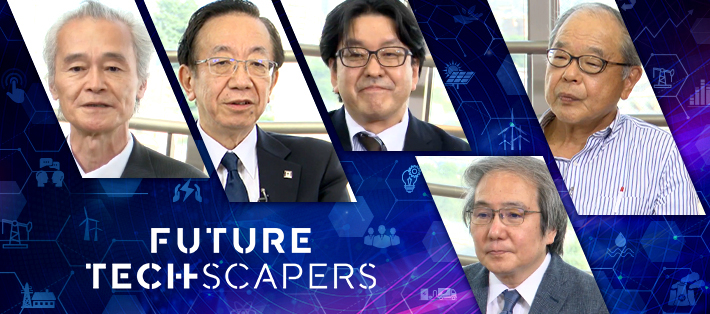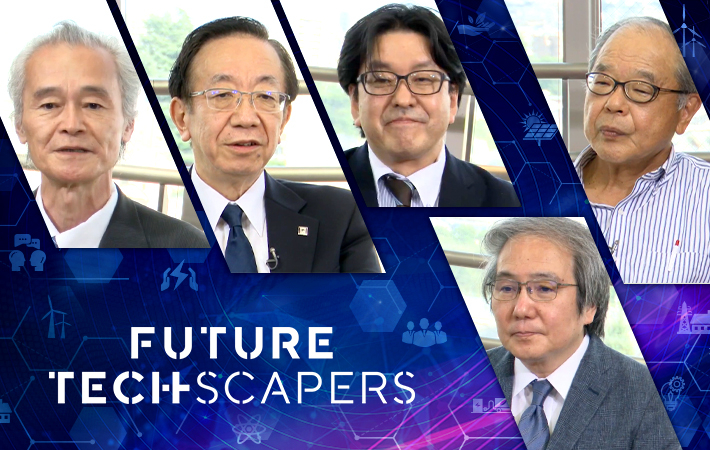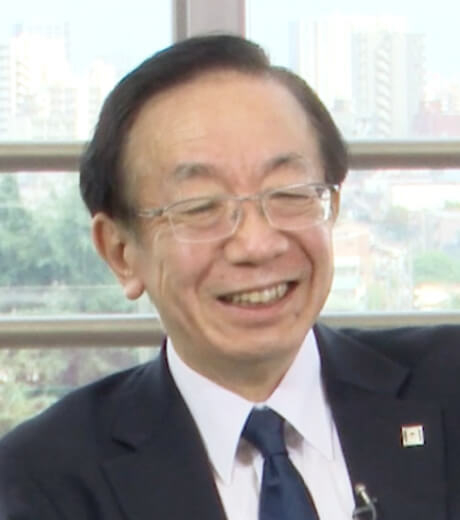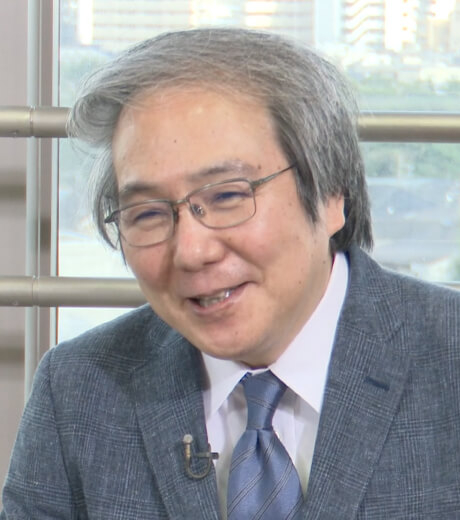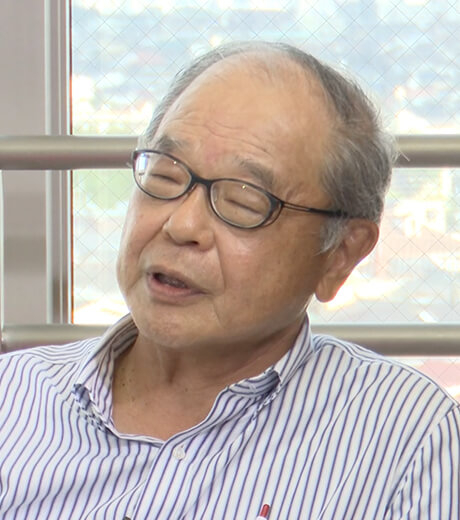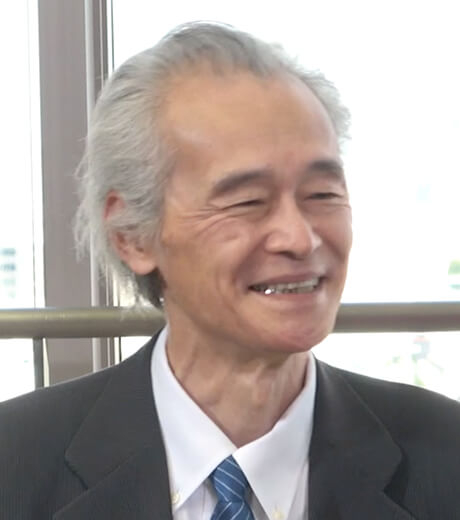DLab dialog for the future
Laboratory for Design of Social Innovation in Global Networks (DLab) has created 24 future scenarios that depict the future we aspire. In the video series "DLab dialog for the future," researchers working at the front lines have selected one of the 24 future scenarios to freely discuss how future advancements in science and technology can contribute to the realization of the scenario.
Reconstructing energy systems to achieve carbon-neutral society
Satoh:Today, we hold a discussion on the theme of energy development for a sustainable society based on DLab's future scenario No. 20 "Eliminate concerns regarding food and energy shortages." To begin with, I would like to ask Professor Takeshita, Director of the Laboratory for Zero-Carbon Energy at Tokyo Institute of Technology (Tokyo Tech), to describe a sustainable energy society in the future.
Takeshita:The Japanese government has set the goal of reducing greenhouse gas emissions by 46% by 2030 from 2013 levels, and of achieving zero net carbon emissions by 2050. However, only about 15% of 19 EJ (exajoule) supplied in Japan in 2019 was zero carbon. To decarbonize the remaining 85% consisting of fossil fuels, it is essential to realize a major transformation of the energy system in Japan.
Considering the best mix of power supplies, we often use S+3E, an acronym for "Safety," "Energy security," "Economic efficiency," and "Environment." Furthermore, to achieve carbon neutrality by 2050, the 3Rs of "Renewable," "Resilient," and "Reliable" are also indispensable conditions.
Seeking to build new energy system resistant to fluctuations
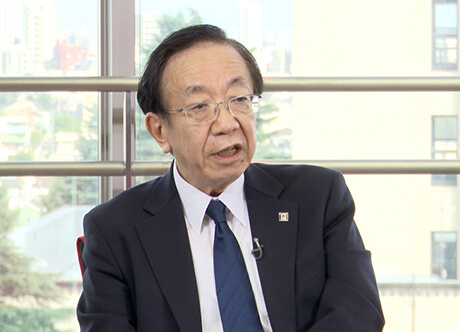
Takeshita:Renewable energy can be the main power source for the achievement of carbon neutrality. However, at present, the generation of stable renewable energy using geothermal and hydropower accounts for 10% of total electric power. It is expected to reach only 15% in the future, and thereby it is necessary to significantly increase the variable renewable energy such as solar power and wind power from the current level of approximately 8%. This leads us to confront electric power shortages in the morning and evening, or output suppression due to oversupply of electric power.
To solve these problems, we seek to build new energy systems equipped with resilience, reliability, and adjustment of power. We do this by developing a storage system that stores electric power and thermal energy. Additionally, the use of nuclear power may be considered as a base load power source that reduces costs and stably generate electricity. Especially in recent years, in addition to a light water reactor, there is progress in the development of compact modular reactors in pursuit of safety and mobility.
Thermal power generation is also the key. Carbon dioxide Capture and Storage (CCS) technology and Carbon dioxide Capture, Utilization and Storage (CCUS) technology that separates and collects CO2 for effective use is expected to be introduced. We also work to generate CO2-free hydrogen and ammonia by using the surplus electric power generated from renewable energy to use as a fuel for generating electric power.
We must consider other forms of energy besides the electric power, which accounts for approximately 75% of energy usage in Japan. Most of the energy other than the electric power is used as heat. Approximately 20% is used for transportation, more than 10% is used for steelmaking, and about 10% is used for petrochemical product materials. Energy carriers such as hydrogen and ammonia will also be fully utilized. Synthetic fuels such as methane and methanol synthesized from CO2 will be used in devices such as fuel cells.
Green Transformation (GX) converts fossil fuels as energy sources into renewable energy and decarbonized gas. It fosters the realization of a carbon-neutral society. Toward this goal, our society is expected to construct an energy system that is resistant to fluctuation, is flexible, and contain a restorative ability. We recognize the importance of stable supply of energy, low carbonization, environmental friendliness, and economic efficiency.
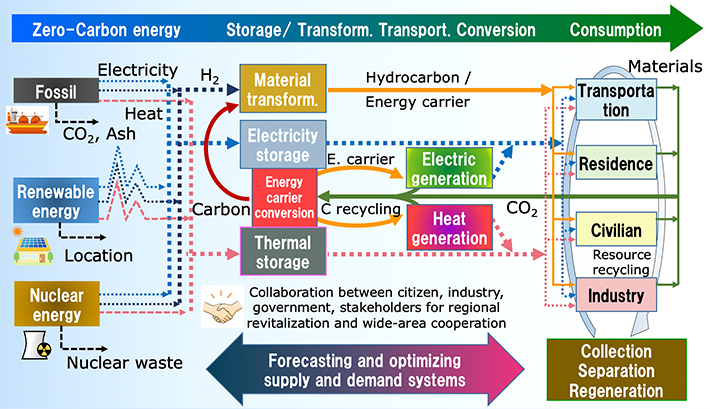
Scenery of energy society by the Laboratory for Zero-Carbon Energy
Communication using quantifiable facts
Satoh:Currently, what kind of research has been conducted at the Laboratory for Zero-Carbon Energy?
Takeshita:Significant advances have been made in research on power storage and heat storage technologies. We have a long-term record of research achievements in fields related to nuclear power, including small modular reactors. In relation to energy other than the electric power, research topics such as carbon cycle steelmaking is being conducted for the decarbonization, which accounts for a large proportion of CO2 emissions.
Satoh:Realization of a zero-carbon society is a theme that concerns studies on energy. Do you have any comments?
Okazaki:My concern is that the term "carbon neutrality" is often misunderstood by the public and the media. Some of them make scientifically incorrect statements such as "as long as CO2 is used to produce methane as fuel, CO2 will decrease", which ignore the production process. When people discuss how to reduce enormous amount of CO2 emissions of about 1.2 billion tons in a year, they get stuck on minute details which are only one millionth of that level.
Experts are expected to make scientific judgments based on net figures and quantitative facts that contribute to zero carbon, and taking into consideration its future potential. I believe that experts on energy studies have the obligation to provide evidence-based information to the public.
How much of sunlight can be converted into electricity?
Satoh:Sunlight is one of the most familiar forms of renewable energies. The amount of energy emitted from the sun is tens of thousands of times greater than the amount of energy consumed on the Earth. I would like to ask Professor Yamada the current updates of photovoltaic power generation.
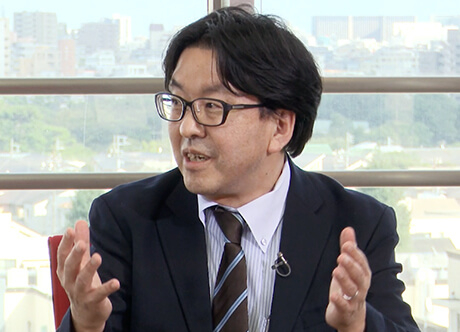
Yamada:The key is the entire energy system; creating, transporting, storing, and using energy. Photovoltaic power generation is the renewable energy that is important in the "creating" phase.
In the mid-latitude zone of the atmosphere, on a clear day, the sun emits approximately 1 kW of light energy per square meter. If we were able to utilize 100% of the solar energy, it would be possible to operate two 500W microwave ovens. However, realistically speaking, it is impossible. Efficiency in conversion is an important indicator to show power generation performance.
For example, if the conversion efficiency is 100%, a solar panel area of 4 m2 is sufficient to achieve an output of 4 kW. However, if the conversion efficiency drops to 10%, the required area will increase by 10 times to 40 m2. The higher the conversion efficiency, the smaller the panel size becomes.
Raising conversion efficiency increases use of solar power generation
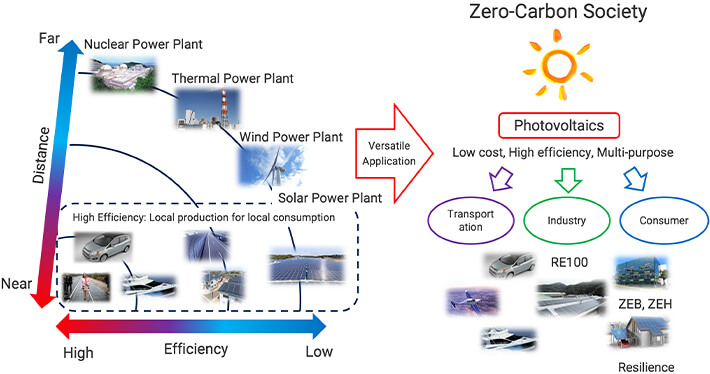
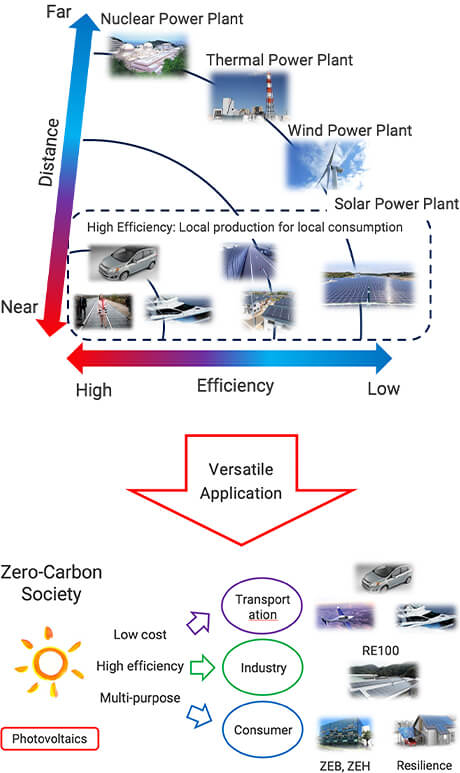
Advantages of Photovoltaic System - Environmentally Friendly System -
Yamada:If we improve the conversion efficiency of the power generation system, we can make the solar panels smaller, lighter, and more flexible. Solar energy will be introduced in a wide range of fields such as transportation, industry, and private use in buildings and homes, and in solar cars.
If we raise the conversion efficiency and realize low-cost, high-efficiency, and versatile solar power generation, it will be utilized into our lives at an even greater rate. We will be able to contribute further to the realization of a carbon-neutral society.
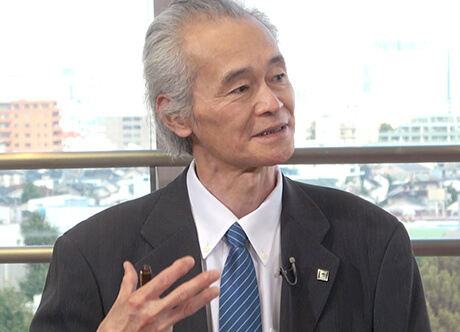
Satoh:What is the conversion efficiency of solar power generation today?
Yamada:A high level of efficiency is about 25%.
Satoh:In the past, some people believed that the energy used to make solar power generation equipment and the energy that can be generated from solar power at the end of the equipment lifespan are basically the same. How about now?
Yamada:We use an index called "energy payback time" which indicates how long it takes to compensate the energy used for manufacturing the power generation unit. Currently, it takes about 18 months to 2 years for an average solar power generation unit. Additionally, we have another index called "CO2 payback time". The CO2 generated during manufacturing can be offset in approximately 18 months to 2 years.
Battery plays supporting role in energy system
Satoh:Fluctuations in the output of renewable energy are unavoidable. Demand for electric power also fluctuates. Storing energy is the essential factor for matching output and demand. Professor Kanno, you conduct research on electrochemical devices such as batteries. Could you please explain a future image of energy storage?
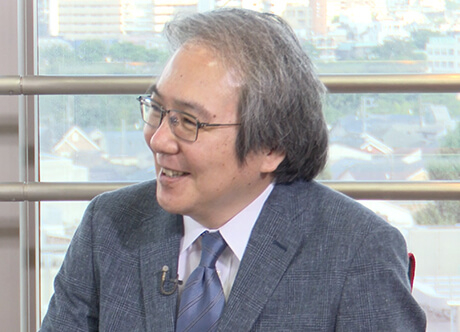
Kanno:A battery can be recharged and used repeatedly after discharging. It is also called a "secondary battery." It is indispensable for the realization of a low-carbon society.
The first battery was invented in 1800 by Volta. 1859 marked the first appearance of the lead-acid battery that is now widely used. In 1991, the lithium-ion battery was put into practical use for the first time in Japan as a "revolutionary battery." 30 years later today, we are trying to install lithium-ion batteries in motor vehicles. Technology of batteries requires time to evolve. A newly developed technology will continue to serve society for 50 to 100 years. Of course, researchers would like to advance their research at a faster pace.
Currently, an important theme in battery research is on how to make high-performance lithium-ion batteries easier to use and more friendly to the environment. Technological development continues for a variety of innovative batteries including air batteries. Fortunately, the solid electrolyte discovered at Tokyo Tech was highly acclaimed as a next-generation battery material in succession to the liquid electrolyte of lithium-ion batteries, which has problems in safety integrity and environmental aspects. An intense research and development efforts have been underway.
Development of next-generation batteries
Kanno:The agenda for the next-generation batteries will be finding a better way of usage. It is also important to make batteries using materials that are environmentally friendly. I hope batteries in the future achieve a larger capacity and become more safe, durable, and easy to use.
Satoh:From the standpoint of endorsing a society to make transition from fossil fuels to electricity, we have high expectations for all-solid-state batteries especially in the transportation field. Electric vehicles currently on the market are equipped with a battery having a capacity of several tens of kWh, which can store more energy than the amount used by ordinary households in one day. I feel that there is a great possibility that batteries will change the way of energy supply.
Although my concern remains whether social infrastructures, such as charging stations, can withstand high demands in power generation and power transmission.
Kanno:When electric vehicles become mainstream, a way of charging and the role of a car may change in the future. With the spread of new technologies, we are about to see great expectations for how society will change.
Building energy system involving Hydrogen

Satoh:The role of hydrogen as a medium for storing and transporting energy is becoming even more important for achieving carbon-neutrality. Professor Okazaki, could you explain the details?
Okazaki:The creation of energy can be seen in the case of ammonia, which is made from hydrogen. Hydrogen is transported in a reduced volume as vaporized hydrogen, organic hydride, and ammonia for the convenience and safety. Ammonia has been attracting attention in recent years not only as a means of transporting hydrogen, but also as a carbon-free fuel.
Additionally, renewable energy such as solar power is now capable of generating electricity in amounts that greatly exceed demand. Therefore, the surplus electric power is used to generate hydrogen and the surplus energy is stored as hydrogen. The stored hydrogen can then be transported and used without any waste.
The world is steadily moving toward a hydrogen society. For example, hydrogen was used in torchers for Tokyo 2020 Olympic and Paralympic Games.
Utilizing potential of hydrogen in the system

Ministry of Economy, Trade and Industry
Note: Photo of the Fukushima Hydrogen Energy Research Field (image only).
In conjunction with the development of water electrolysers, demonstration tests will be conducted in combination with the heat-related equipments such as boilers and basic chemicals manufacturing processes in order to optimize the entire system for decarbonization of the non-power sectors using renewable energy power sources, etc.
Hydrogen Production through Water Electrolysis Using Power from Renewables
Okazaki:The key to advancing the use of hydrogen is the technology of water electrolysis, which uses renewable energy power to electrolyze water to produce CO2-free hydrogen and methane. To realize a hydrogen-based society, it is essential to increase the efficiency, extend the service life, and lower the cost of the technology.
At Tokyo Tech, cutting-edge research is being conducted, including basic modeling of water electrolysis, the in-situ measurement of water behavior in fuel cells, and on gas turbines for power generation using hydrogen as combustion. Tokyo Tech faculty members have developed a new method of ammonia synthesis using hydrogen and nitrogen, an alternative to the conventional Haber-Bosch process.
A point to keep in mind is to consider the net contribution to carbon neutrality factoring in the production process of hydrogen. Hydrogen are dubbed in gray, green, or blue based on the production process. "Gray hydrogen" is produced from ordinary fossil fuels. "Green hydrogen" is made from renewable energy and is CO2-free. "Blue hydrogen" is CO2 removed gray hydrogen through a process of Carbon Capture and Storage (CCS), and has a different meaning from the original CO2 free hydrogen.
"Methanation" is a process synthesized by reacting CO2 emitted from factories and power stations with hydrogen. Unless the emitted CO2 is returned to its initial CO2 source, this cannot be considered as carbon neutral. At Tokyo Tech, I hope we can contribute to the realization of a carbon-free society through optimal use of its technological capabilities.
Satoh: I expect great outlook for green hydrogen developments, and especially the future use of ammonia.
Okazaki:Hydrogen is only one part of the energy system. It is important to organically combine hydrogen with various technologies such as renewable energy and batteries for the best system efficiency.
The utility of DLab in agendas concerning energy
Satoh:Tokyo Tech has prestigious research outcomes that help build a zero-carbon society. I think it is necessary to present a holistic view of the various stages of energy creation, transportation, storage, and the usage. Would anyone wish to share their thoughts?
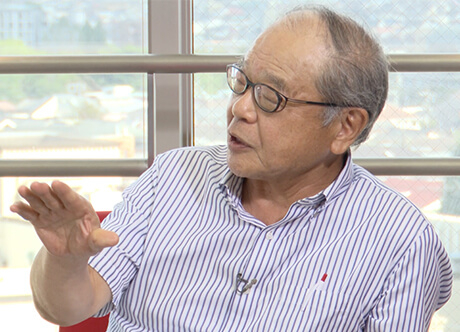
Okazaki:We continue to improve technologies concerning the entire energy system. I believe the role of DLab lies in re-capturing the idea and the concept of the conventional energy system, and its comprising processes.
Satoh:I agree. When researchers disseminate information, they tend to talk about what "must" be done. At DLab, we focus on what we "seek" to be done, instead of what "ought" to be done. The future we seek is aligned with aspirations desirable to our society for creating a brighter, a more prosperous world.
Many high school students participated in DLab workshops have shared fascinating ideas. DLab aims to create a positive cycle of communication with people, ascertaining their expectations, and developing science and technology for a better tomorrow.
Construction of sustainable energy society by integrating knowledge from wide variety of research fields
Yamada:Japan continues to import various types of energy, but can we rely on imports? I felt that it is important to look at how to secure the energy in a stable and affordable manner.
Satoh:Energy imports have geopolitical risks such as the relationship between countries. I would like to encourage people who are engaged in research to join into the discussion. Professor Okazaki, you have been involved in many industry-government-academia collaborations and global research collaborations in the hydrogen field, how do you see the future prospect?
Okazaki:It is necessary to consider energy issues including social sciences perspectives. The scope of the agenda is wide, and it is difficult to solve them only with technical expertise from natural sciences. In 2019, Tokyo Tech established the InfoSyEnergy Research and Education Consortium. This Consortium conducts energy research and fosters industry-university collaboration while integrating fields of information science, social science, and basic technology developments.
Toward carbon-neutral society
Satoh:Professor Takeshita, would you please summarize and conclude our discussion today.
Takeshita:A carbon-neutral society can be described as a society that uses renewable energy as its main power source. However, the output of renewable energies is unstable, so it is essential to develop technologies and mechanisms to resolve this instability.
Future developments in storing electricity in batteries, extensive use of energy carriers such as hydrogen and ammonia, and establishing a carbon cycle system is necessary to resolve the instability challenges. We also need to incorporate nuclear power, which can be used safely as a base load power source. It is important to skillfully combine these various technologies to create a flexible energy system that is resilient to fluctuations and has restorative capability.
Satoh:Thank you all for your time today. Tokyo Tech will continue creating platforms for open dialog to discuss global agendas such as food sources, which is also an aspect of future scenario No. 20 "Eliminate concerns regarding food and energy shortages", unfortunately we could not touch upon today. I look forward to having you back for further discussions in the future.


DLab Future Techscapers
A video series including "DLab dialog for the future." Researchers discuss their research based on future scenarios. "Techscapers" is a word combined with "Technology" and "Landscape." This series features people with a broad view of technology and society.
The Special Topics component of the Tokyo Tech Website shines a spotlight on recent developments in research and education, achievements of its community members, and special events and news from the Institute.
Past features can be viewed in the Special Topics Gallery.
. Any information published on this site will be valid in relation to Science Tokyo.


